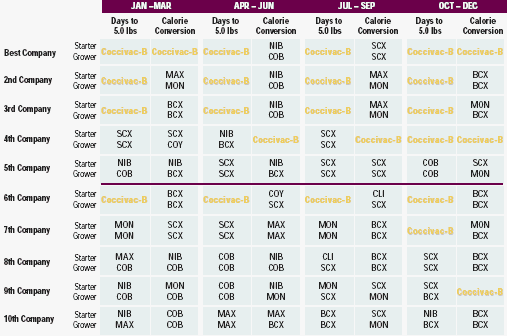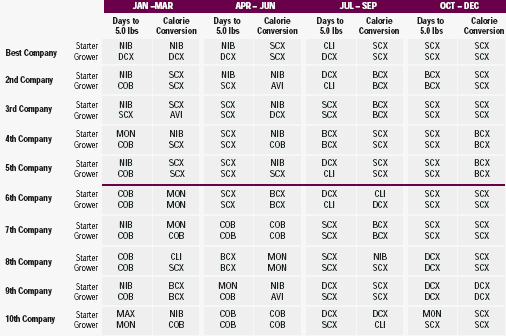Vaccination: Rising To The Top
A national report shows that of 10 poultry complexes with the best results for "days to 5 pounds" in 2006, the top three were using Coccivac-B vaccine instead of a traditional in-feed anticoccidial for coccidiosis control.
The complex with the best result for
calorie conversion was also using the
vaccine instead of anticoccidials for
two of four time periods in 2006,
according to the survey (Table 1).
Overall, at least four complexes
among the top 10 industry performers
for days to 5 pounds (2.27 kg) were
using Coccivac-B at some time in 2006;
between one and three of the top 10
performers for calorie conversion were
using Coccivac-B.
In striking contrast, the same report
in 2003 showed that none of the complexes
using Coccivac-B were among
the top 10 for days to 5 pounds (Table
2).
The report was prepared by Agri
Stats, Inc., a statistical research and
analysis firm that receives data monthly
from 160 poultry complexes owned
by various poultry companies. Agri
Stats annually compiles the figures and
provides comparisons.
Agri Stats also found that for several
months in 2006, many of the complexes
using Coccivac-B were also in the
top 10 for adjusted feed ingredient
expense - the feed cost/pound of live
weight, which quantifies feed conversion
ratios by dollars and cents.

Analysis of specific results averaged out for all complexes and for birds by weight categories (Table 3) underscores the positive results - broilers vaccinated with Coccivac-B against coccidiosis had better adjusted calorie conversion and fewer days to 5 pounds compared to those on in-feed anticoccidials. Average mortality was similar except for the over 6-pound (2.72-kg) category, where it was considerably lower among Coccivac-B vaccinated birds.

Enhances profits
"Good results for days to 5 pounds is
important because this parameter
reflects daily weight gain," says Dr.
Marcelo Lang, a veterinarian and poultry
marketing director for Schering-
Plough Animal Health. Fewer days to 5
pounds improves the utilization of
poultry houses and helps growers reap
better profits, which enhances grower
relations, he says.
"It's an overall sign of good health
and an indication that the birds are

Source: Agri Stats, Inc.
*Feed meds $/ton is a difficult comparison to make since feed costs are determined by ton and the cost of Coccivac-B is based on the number of birds. A fairer comparison would factor in the increased cost of chick vaccination for the same complexes, but data is not now available.
growing to their full potential," Lang
adds.
Why are so many complexes using
Coccivac-B now in the top 10 but were
not just a few years ago? "We can only
guess," says Lang. "From these data, we
cannot say that Coccivac-B is responsible
for the good results at top-performing
complexes, but we can surmise
that Coccivac-B is contributing to
their success.
"It could be management changes
or that problems with traditional infeed
anticoccidials, such as resistance,
have intensified. It could also reflect
the improved advice we give to customers
about how to get the best
results with the vaccine, or the fact that
several companies that used Coccivac-
B in 2006 were repeat users, and we've
seen many times that performance with
Coccivac-B tends to improve with
repeat usage," he says.
The new data should help dispel
the notion that using Coccivac-B for
coccidiosis control slows broiler
growth. "Based on our experience in
the field and this recent Agri Stats
report, it is apparent that complexes
using Coccivac-B coupled with good
management can achieve weight gain
and calorie conversion ratios that are
among the best in the entire industry,"
Lang says.







